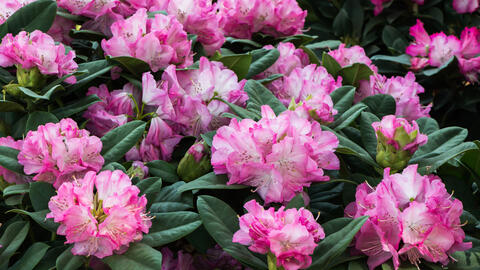The correct way to plant Rhododendron
Rhododendron is best planted between the and of April and the start of May. We show you the best approach and provide you with tips about the location, soil and additional care.

Rhododendron in full bloom
If you are looking to plant a Rhododendron, you should find out the correct location in the garden, the soil conditions in the planting spot and the subsequent care, in advance. Because: For a Rhododendron to develop its striking flowers to the fullest, it’s important to create conditions which are similar to its natural location right from the start. The parent species of today’s Rhododendron varieties grow in bright, deciduous forests on humus-rich, lime deficient and evenly moist soils with a high proportion of decomposing leaves and other plant remains. This can also be seen in the Rhododendron roots: They are very flat and dense and have such a high proportion of fine roots that you often don’t even need to bother with a ball cloth when repotting. The large proportion of fine roots are perfect for absorbing the necessary nutrients from well aerated soils in its natural location.
You should simulate the location conditions in its native forests as closely as possible in order to successfully cultivate rhododendrons. The perfect location should be slightly shady, so that the Rhododendron is not positioned in direct sunshine during the middle of the day. However, the spot should not be too shady for your rhododendron as otherwise it will put out fewer flowers. Rhododendron experts recommend the Scotch pine (Pinus sylvestris) as the ideal shade providing tree for your rhododendron bed. This creates a light shade with its long, thin needles and has deep, less branched roots, which do not represent any competition for the Rhododendron roots.

The exception to the rule: In contrast to most other rhododendron, the flat and wide-growing Yakushimanum hybrids also grow in sunny locations. It’s fresh buds have a mealy coating which protects the plants against strong rays of sunlight.
The soil for planting Rhododendrons must be loose and humus-rich, just like their natural location. The plant will fail in heavy, loamy soils as its roots cannot spread out. Therefore, be sure to replace the soil if it has unfavorable ratios. For this, dig a 20 inch deep hole for each plant with a diameter of at least 59 inches. The loamy, dug out soil is then replaced by a mixture of equal parts bark compost, sand and - if available - well matured cow dung. Prevent waterlogging by also spreading a layer of coarse building sand about 3.94 inches thick in the bottom of the planting hole. In sandy soils, it is generally sufficient if you work in plenty of bark compost and also into the soil before planting. Alternatively, you can improve the soil using standard Rhododendron potting soil.

Rhododendrons are generally supplied in a pot or with a naked root ball. Dig an accordingly large planting hole in the prepared location, place the rhododendron in with the root ball and carefully tread down the soil. The top of the root ball should not be covered with soil: If a Rhododendron is planted too deep, its sensitive roots will die and the plant will shrink. Therefore, it is better to leave the root ball protruding about an inch out of the ground.
After planting, water the Rhododendron well and fertilize with a handful or two of horn shavings. Spread the horn shavings generously in the root area. Finally, give the plant about a 1.97 inch deep mulch layer of bark mulch or compost. As in its natural location, this prevents the soil from drying out and heavy temperature fluctuations.
You should plant the slightly more expensive Inkarho rhododendron in unfavorable soil conditions. This is a normal Rhododendron variety but it is grafted to a special, relatively lime-tolerant rootstock. The rootstock is bred from the ‘pool of lime-tolerant rhododendrons’. Attempts have proven that these plants also show sufficient root growth in loamy soils which are not lime-free. However, you still need to thoroughly loosen such soils and enrich them with plenty of humus.



